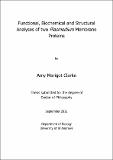Functional, biochemical and structural analyses of two plasmodium membrane proteins
Abstract
Protozoan parasites of the genus Plasmodium are the causative agent of malaria. The most severe form of human malaria is caused by P. falciparum, responsible for approximately three quarters of a million deaths each year. One major problem in the treatment of malaria is resistance to existing chemotherapies. Consequently, there is an urgent need to identify and validate novel drug targets.
A possible recently identified drug target is the PfNitA protein of P. falciparum which contains orthologues in other Plasmodium species but is absent from humans. The gene is annotated as a putative formate-nitrite transporter and orthologues are found in a range of prokaryotes as well as the lower eukaryotes algae and fungi. To determine the biological function of the protein, pfnita was expressed in Escherichia coli strains lacking the endogenous formate and nitrite transporters. In order to analyse the essentiality of the gene a reverse genetics approach was taken and the data discussed. Results indicate that the PfNitA protein is located in the plasma membrane and digestive vacuole of intraerythrocytic parasites suggesting a role in the uptake or excretion of metabolites.
A second complexity with regard to treatment is the lack of a vaccine. A problem in crating a vaccine is antigenic variation. The PIR family of proteins contain a so-called hypervariable domain that has led to the suggestion that the family may play a role in antigenic variation. The objective of the work carried out in this thesis was to investigate the topology and structure of the PcCir2 protein of Plasmodium chabaudi, using E. coli as the expression host. The topology of Cir2 has been examined by means of reporter fusions and overexpression/purification studies undertaken towards crystallisation. As the PcCir2 amino acid sequence does not show significant homology to other proteins, structural data may provide insights into potential functional or binding domains.
Type
Thesis, PhD Doctor of Philosophy
Collections
Items in the St Andrews Research Repository are protected by copyright, with all rights reserved, unless otherwise indicated.

